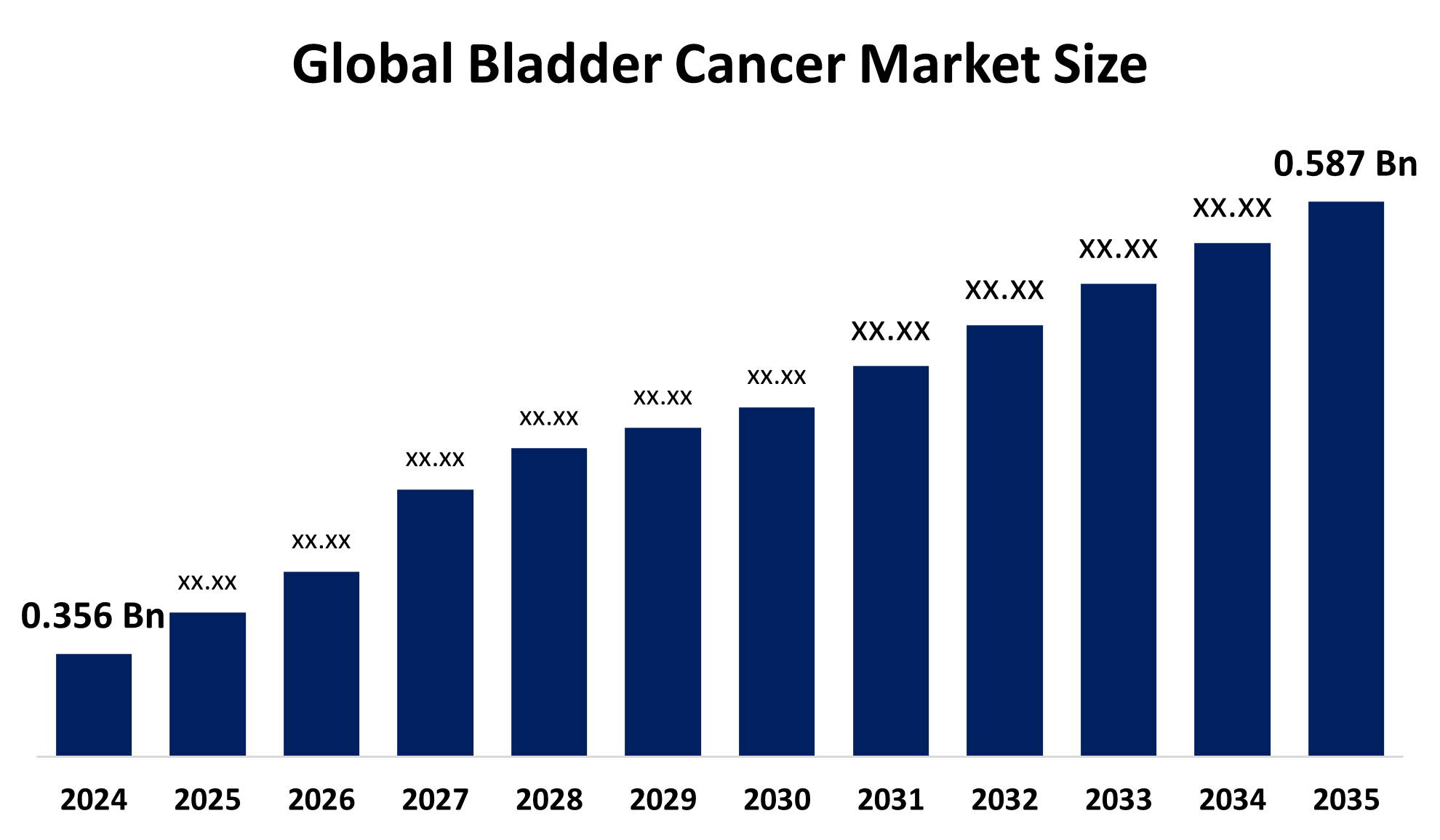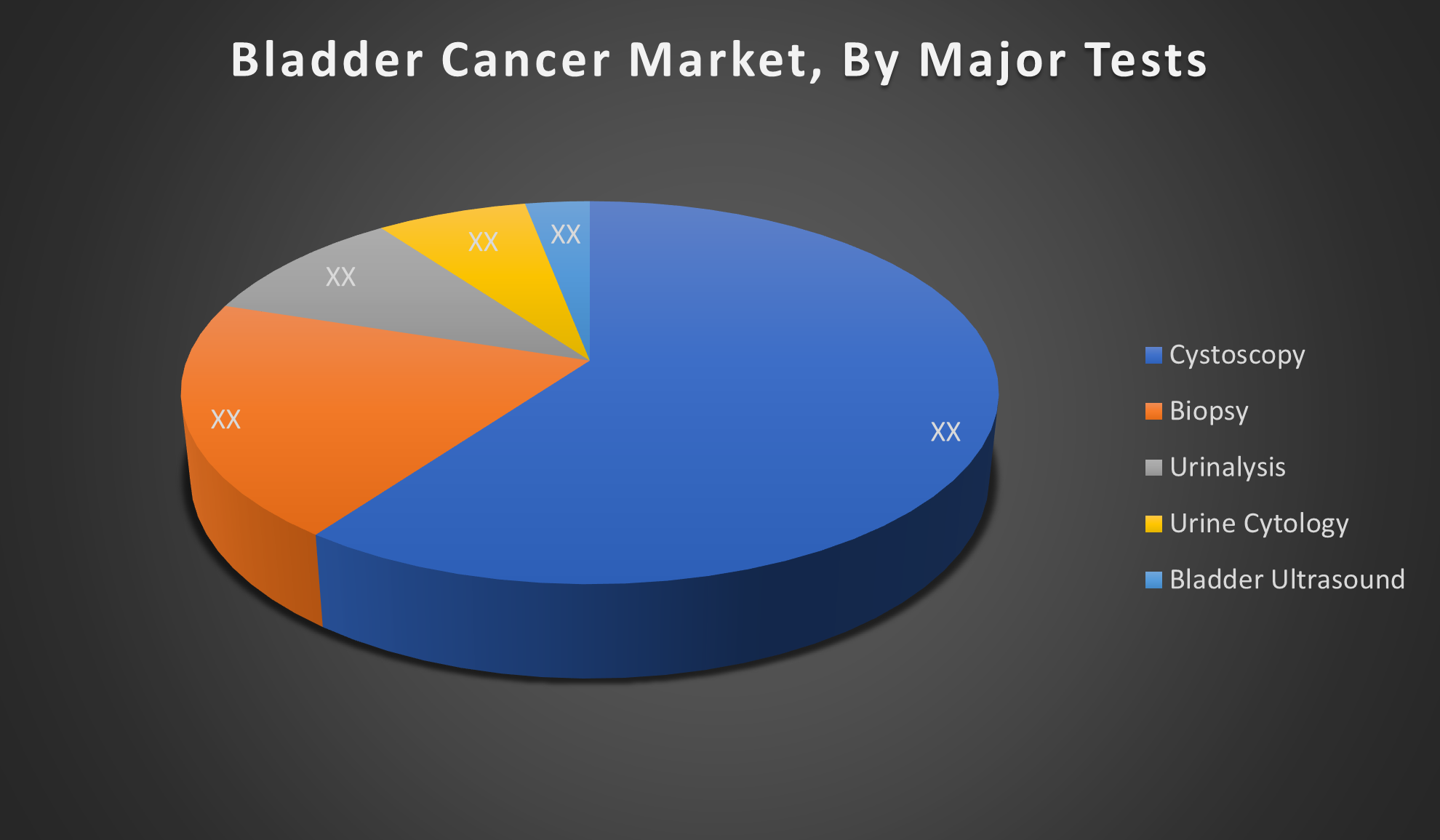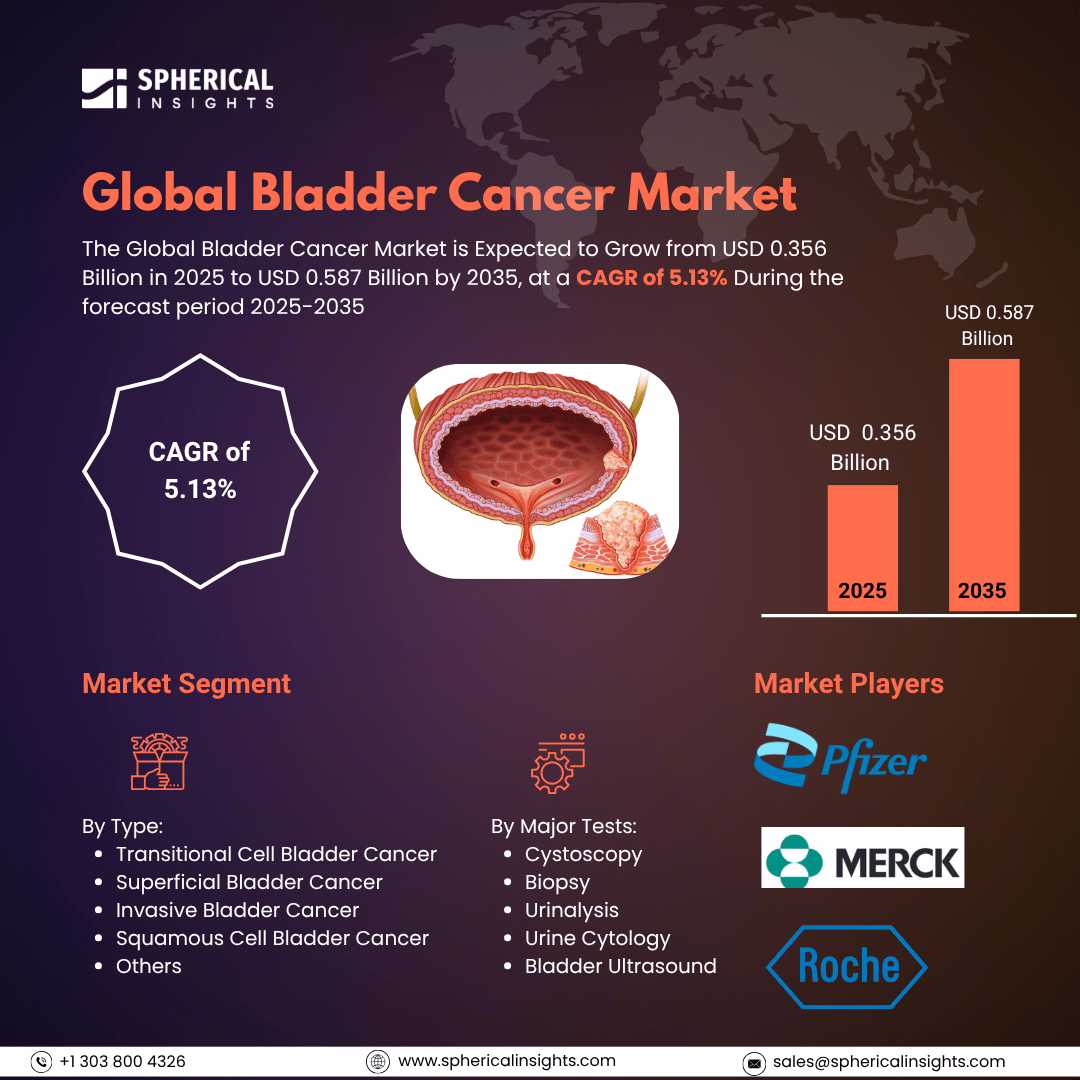- As per Spherical Insights & Consulting, The Global Bladder Cancer Market Size is Expected to Grow from USD 0.356 Billion in 2024 To USD 0.587 Billion by 2035, at a CAGR of 5.13% during the forecast period 2025-2035, owing to the launch of new therapies in the market and the rise in the number of cases.
- The leading Bladder Cancer Market Companies such as Pfizer, Merck & Co., Roche, Bristol-Myers Squibb, AstraZeneca, Johnson & Johnson, Novartis, Eli Lilly, Ipsen, F. Hoffmann-La Roche, Bayer, Amgen, Sanofi, AbbVie, GlaxoSmithKline, and Others.

Bladder Cancer Treatment Market: Understanding and Treatment Algorithm:
Bladder cancer is a common malignancy that begins in the cells lining the bladder, the organ responsible for storing urine. It often presents with symptoms like blood in the urine, frequent urination, and pain during urination. Early detection is crucial, as many cases are treatable when caught early. Treatment options vary based on cancer type and stage, including surgery, chemotherapy, immunotherapy, and radiation.
Bladder Cancer Diagnosis:
Bladder cancer diagnosis involves a combination of tests, including cystoscopy for direct bladder visualization, biopsy for tissue analysis, and urine tests like cytology and urinalysis to detect cancer cells. Imaging techniques such as ultrasound or CT scans help assess tumour size and spread. Early and accurate diagnosis is vital for effective treatment planning and improved outcomes.
Bladder Cancer Treatment
Bladder cancer treatment depends on the cancer type and stage, including surgery to remove tumours or the bladder, intravesical therapies that deliver medication directly into the bladder, chemotherapy, immunotherapy to boost the immune system, and radiation therapy. Early-stage cancers often use localized treatments, while advanced cases may require systemic therapies for better control.
Bladder Cancer Epidemiology
The disease epidemiology covered in the report provides historical as well as forecasted epidemiology segmented by Total Diagnosed Incident Population of Bladder Cancer, Gender-specific Diagnosed Incidence of Bladder Cancer, Type-specific Diagnosed Incidence of Bladder Cancer, Age-specific Diagnosed Incidence of Bladder Cancer, Diagnosed Incident Population based on Primary Site of Bladder Cancer, and Diagnosed Incident Population based on Histologic Classification of Bladder Cancer Tumour in the global market covering North America, Europe, Asia-Pacific, Latin America, the Middle East, and Africa from 2024 to 2035.
Principal Insights
This section offers a global overview of bladder cancer epidemiology in major markets worldwide.
Country Wise- Bladder Cancer Multiforme Epidemiology
- The epidemiology segment provides Bladder Cancer prevalence data and findings across key regions worldwide, including North America, Europe (Germany, France, Italy, Spain, and the United Kingdom), Asia-Pacific (including Japan), Latin America, the Middle East, and Africa.
Bladder Cancer Marketed Drugs:
Keytruda (pembrolizumab) is an anti-PD-1 monoclonal antibody that boosts the immune response against tumours. It is FDA-approved for advanced or metastatic urothelial carcinoma, particularly in patients ineligible for cisplatin-containing chemotherapy or with disease progression after prior treatment.
- Padcev: Astellas Pharma / Pfizer / Seagen
Padcev (enfortumab vedotin) is an antibody-drug conjugate that targets Nectin-4, a protein highly expressed in urothelial cancer cells. It is approved for locally advanced or metastatic urothelial cancer in patients previously treated with platinum-containing chemotherapy and a PD-1/PD-L1 inhibitor.
- Balversa: Janssen Pharmaceuticals
Balversa (erdafitinib) is an FGFR kinase inhibitor approved for patients with locally advanced or metastatic urothelial carcinoma that harbors FGFR2 or FGFR3 genetic alterations. It is used after progression following platinum-based chemotherapy.
Bladder Cancer: Emerging Therapies
- Anktiva: It is an IL-15 superagonist designed to stimulate both NK and T cells. Recently FDA-approved for BCG-unresponsive non-muscle invasive bladder cancer (NMIBC), it is also being evaluated in combination therapies to improve immune response in advanced disease stages.
- BNT327: It is a bispecific antibody in late-stage clinical trials for bladder cancer. It targets two immune checkpoints simultaneously to enhance T-cell activation and tumor response, aiming to benefit patients resistant to standard PD-1/PD-L1 therapies.
- Sasanlimab: It is a PD-1 inhibitor currently under investigation in combination with BCG therapy. In Phase III trials, it showed significant improvement in event-free survival in high-risk, BCG-naïve NMIBC patients, positioning it as a potential frontline immunotherapy.
- Vicinium: It is a fusion protein combining an antibody fragment targeting EpCAM with a cytotoxic payload. It is designed for intravesical use in NMIBC patients unresponsive to BCG, aiming to deliver tumor-specific cytotoxicity with minimal systemic exposure.
Bladder Cancer Market Outlook
- The Global Bladder Cancer Market refers to the entire ecosystem involved in the diagnosis, treatment, management, and research of bladder cancer. It includes pharmaceuticals, biologics, diagnostics, surgical interventions, and supportive care products. The market spans various stages and types of bladder cancer, including non-muscle invasive and advanced forms, and involves healthcare providers, manufacturers, and research institutions working to improve patient outcomes and expand therapeutic options.
- The bladder cancer market is driven by rising global incidence, growing elderly population, advancements in immunotherapy and targeted treatments, and increasing awareness and screening programs. Enhanced diagnostic technologies, improved healthcare infrastructure, and government support further contribute to the market’s expansion and innovation.
- The bladder cancer market offers opportunities through development of novel immunotherapies, targeted treatments for resistant cases, and personalized medicine approaches. Growing investments in oncology research, expanding access in emerging markets, and integration of advanced diagnostics and biomarkers further enhance potential for improved outcomes and market growth.
- Governments support bladder cancer care through early detection programs, public insurance schemes, and financial aid for treatment. Initiatives like India's Ayushman Bharat and National Cancer Control Programme aim to improve access, standardize care, and expand oncology infrastructure nationwide.
- Limited early detection methods and high treatment costs remain major challenges in the bladder cancer market.
- The global bladder cancer therapeutics market is projected to grow steadily due to advancements in treatment options and increased disease awareness.
Bladder Cancer Market Segmentation
By Type:
- Transitional Cell Bladder Cancer
- Superficial Bladder Cancer
- Invasive Bladder Cancer
- Squamous Cell Bladder Cancer
- Others

The Transitional Cell Bladder Cancer segment dominates the global bladder cancer market because it accounts for approximately 90% of all bladder cancer cases. Its high prevalence drives demand for targeted diagnostics and treatments. Additionally, ongoing research and the availability of various therapeutic options focused on this subtype contribute to its market leadership.
By Major Tests:
- Cystoscopy
- Biopsy
- Urinalysis
- Urine Cytology
- Bladder Ultrasound

The Cystoscopy segment dominates the global bladder cancer testing market because it is the gold standard for diagnosis and monitoring. It allows direct visualization of the bladder lining and enables biopsy collection. Its high accuracy and widespread use in detecting and managing bladder cancer cases drive its leading position over other diagnostic tests.
Regional Segment Analysis of the Bladder Cancer Market
North America holds the largest share of the global bladder cancer market. This dominance is primarily attributed to the region’s advanced healthcare infrastructure, high awareness about bladder cancer, widespread adoption of innovative treatment technologies, and strong presence of key market players. Additionally, the increasing incidence rate of bladder cancer in the United States and Canada, coupled with favourable government initiatives and reimbursement policies, continues to drive market growth. Robust research and development activities and accessibility to early diagnosis tools further solidify North America’s leading position in the market.
The Asia-Pacific region is projected to be the fastest-growing segment in the bladder cancer market during the forecast period. This rapid growth is driven by rising cancer prevalence, increasing healthcare expenditure, and improving medical infrastructure in emerging economies such as China and India. Growing awareness of bladder cancer, along with government efforts to enhance cancer screening and treatment programs, is accelerating the demand for advanced diagnostic and therapeutic options. Moreover, the entry of multinational pharmaceutical companies and the expansion of clinical trials in the region contribute significantly to its escalating growth rate.
Bladder Cancer Market Key Companies
- Pfizer
- Merck & Co.
- Roche
- Bristol-Myers Squibb
- AstraZeneca
- Johnson & Johnson
- Novartis
- Eli Lilly
- Ipsen
- F. Hoffmann-La Roche
- Bayer
- Amgen
- Sanofi
- AbbVie
- GlaxoSmithKline
- Others
Bladder Cancer Therapeutics Market Report Scope
- The Bladder Cancer therapeutics market report provides a detailed overview, covering its causes, symptoms, disease progression, and existing treatment options.
- Detailed insights into Bladder Cancer’s epidemiology and therapeutic approaches are included.
- Additionally, a comprehensive review of existing and emerging Bladder Cancer therapies is provided, including an evaluation of new treatments expected to influence the current Bladder Cancer treatment market landscape.
- The report includes a detailed review of the Bladder Cancer therapeutics market, both historical and forecasted, highlighting the global drug reach.
- The Patient-Based Bladder Cancer Market Forecasting report offers valuable insights into trends shaping the global Bladder Cancer market, helping to develop effective business strategies.
Bladder Cancer Treatment Market Report Insights
- Forecasting Market Trends Based on Patient Data and Disease Rates
- Bladder Cancer Therapeutic Approaches in Bladder Cancer
- Review Of Drugs in Development for Bladder Cancer
- Market, Growth, and Trends in Bladder Cancer
- Market Opportunities in Bladder Cancer Treatment
- Effects Of Future Therapies on Bladder Cancer Treatment.
Bladder Cancer Treatment Market Report Key Strengths
- 15 Years Bladder Cancer Market Forecast
- Global Coverage
- Bladder Cancer Epidemiology Segmentation
- Key Cross Competition
Bladder Cancer Treatment Market Report Assessment
- Present Practices in the Bladder Cancer Treatment Market
- Review of Investigational Bladder Cancer Drugs
- Attractiveness of the Bladder Cancer Drug Market
- Bladder Cancer Market Drivers
- Bladder Cancer Market Barriers
- SWOT
- Attribute Analysis
Market Segment
This study forecasts revenue at the global, regional, and country levels from 2020 to 2035. Spherical Insights has segmented the bladder cancer market based on the below-mentioned segments:
Global Bladder Cancer Market, By Type
- Transitional Cell Bladder Cancer
- Superficial Bladder Cancer
- Invasive Bladder Cancer
- Squamous Cell Bladder Cancer
- Others
Global Bladder Cancer Market, By Major Tests
- Cystoscopy
- Biopsy
- Urinalysis
- Urine Cytology
- Bladder Ultrasound
Global Bladder Cancer Market, By Regional Analysis
- North America
- Europe
- Germany
- UK
- France
- Italy
- Spain
- Russia
- Rest of Europe
- Asia Pacific
- China
- Japan
- India
- South Korea
- Australia
- Rest of Asia Pacific
- South America
- Brazil
- Argentina
- Rest of South America
- Middle East & Africa
- UAE
- Saudi Arabia
- Qatar
- South Africa
- Rest of the Middle East & Africa






